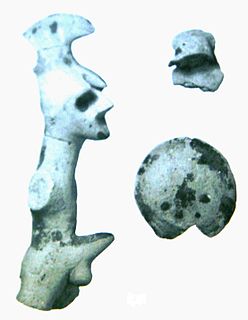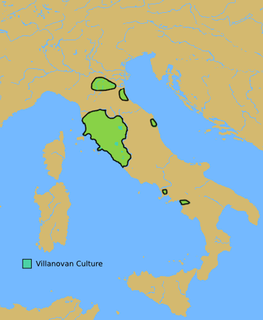 W
WThe prehistory of Italy began in the Paleolithic period, when the Homo species colonized the Italian territory for the first time, and ended in the Iron Age, when the first written records appeared in the Insular Italy.
 W
WThe Apennine culture is a technology complex in central and southern Italy from the Italian Middle Bronze Age. In the mid-20th century the Apennine was divided into Proto-, Early, Middle and Late sub- phases, but now archaeologists prefer to consider as "Apennine" only the ornamental pottery style of the later phase of Middle Bronze Age (BM3). This phase is preceded by the Grotta Nuova facies and by the Protoapennine B facies and succeeded by the Subappennine facies of 13th-century. Apennine pottery is a burnished ware incised with spirals, meanders and geometrical zones, filled with dots or transverse dashes. It has been found on Ischia island in association with LHII and LHIII pottery and on Lipari in association with LHIIIA pottery, which associations date it to the Late Bronze Age as it is defined in Greece and the Aegean.
 W
WThe Campanian Ignimbrite eruption was a major volcanic eruption in the Mediterranean during the late Quaternary, classified at 7 on the Volcanic Explosivity Index (VEI). The event has been attributed to the Archiflegreo volcano, the 13-kilometre-wide (8.1 mi) caldera of the Phlegraean Fields, located 20 km (12 mi) west of Mount Vesuvius under the western outskirts of the city of Naples and the Gulf of Pozzuoli, Italy. Estimates of the date, magnitude and the amount of ejected material have varied considerably during several centuries of investigation. This applies to most significant volcanic events that originated in the Campanian Plain, as it is one of the most complex volcanic structures in the world. However, continued research, advancing methods and accumulation of volcanological, geochronological, and geochemical data has amounted to ever more precise dating.
 W
WThe Este culture or Atestine culture was an Iron Age archaeological culture existing from the late Italian Bronze Age to the Roman period. It was located in the present territory of Veneto in Italy and derived from the earlier and more extensive Proto-Villanovan culture. It is also called "civilization of situlas", or paleo-venetic.
 W
WThe Golasecca culture was a Late Bronze Age/Early Iron Age culture in northern Italy, whose type-site was excavated at Golasecca in the province of Varese, Lombardy, where, in the area of Monsorino at the beginning of the 19th century, Abbot Giovanni Battista Giani made the first findings of about fifty graves with pottery and metal objects.
 W
WThe archaeological site of Polizzello or mountain of Polizzello was a site inhabited probably from the eleventh to the sixth century BC
 W
WThe Thapsos Culture is defined as the civilization in ancient Sicily attested by archaeological findings of a large village located in the peninsula of Magnisi, between Augusta and Syracuse, that the Greeks called Thapsos.I believe I have demonstrated the influence, albeit in a smaller scale of Mycenaean architecture in front of burials of the islet Magnisi; here that influence affirms for the most part. - Paolo Orsi.
 W
WThe Villanovan culture, regarded as the earliest phase of the Etruscan civilization, was the earliest Iron Age culture of Central Italy and Northern Italy. It directly followed the Bronze Age Proto-Villanovan culture which branched off from the Urnfield culture of Central Europe. This gave way in the 7th century BC to an increasingly orientalizing culture influenced by Greek traders and colonists who settled in South Italy.